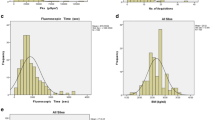Abstract
Objective. We assessed the relative radiation load in patients undergoing hydrostatic and pneumatic reduction of childhood intussusception.Materials and methods In a phantom study we simulated two situations occurring during reduction of intussusception. The absorbed radiation dose was measured at several positions in the phantom using either barium sulphate (BaSO4) or air in the simulated reduction, combined with either automatic exposure control (AEC) or constant exposure rate (CER) at fluoroscopy. From these values the mean absorbed dose was calculated for different depth compartments within the phantom.Results. In the barium study the mean absorbed dose averaged over the total irradiated volume was 14–23 % lower when CER was used instead of AEC; in the air study the dose was 35–43 % lower when AEC was used instead of CER. The combination of air and AEC provided the lowest mean absorbed dose in the tissue. The barium enema created a low-radiation zone, which might be utilized for protecting radiation sensitive tissue.Conclusion. The use of BaSO4 or air in reduction of intussusception requires the proper combination with CER and AEC, respectively, to minimize the radiation load to the patient; the lowest radiation load is obtained by using air and AEC.
Similar content being viewed by others
References
Karlsson A, Schuwert P, Mortensson W (1994) Radiation exposure to the child in diagnosing and at hydrostatic reduction of intussusception. Acta Radiol 35: 296–299
Stringer D, Fin S (1990) Pneumatic reduction: advantages, risks and indications. Pediatr Radiol 20: 475–477
Calzado A, Vano E, Morán P, Castellote C, Ruiz S, Gonzáles L (1991) Estimation of doses to patients from “complex” conventional X-ray examinations. Br J Radiol 64: 539–546
Birch R, Marshall M, Adran GM (1979) Catalogue of spectral data for diagnostic X-rays. Hospital Physics Association, London, Report, no 30
Sandborg M, Alm Carlsson G, Persliden J, Dance D (1992) Comparison of different materials for test phantoms in diagnostic radiology. Radiat Prot Dosim 49: 345–347
Alm Carlsson G (1973) Dosimetry at interfaces - theoretical analysis and measurements by means of thermoluminescent LIF-dosimeters. Acta Radiol Suppl 332: 37
Author information
Authors and Affiliations
Rights and permissions
About this article
Cite this article
Persliden, J., Schuwert, P. & Mortensson, W. Comparison of absorbed radiation doses in barium and air enema reduction of intussusception: A phantom study. Pediatr Radiol 26, 329–332 (1996). https://doi.org/10.1007/BF01395708
Received:
Accepted:
Issue Date:
DOI: https://doi.org/10.1007/BF01395708




